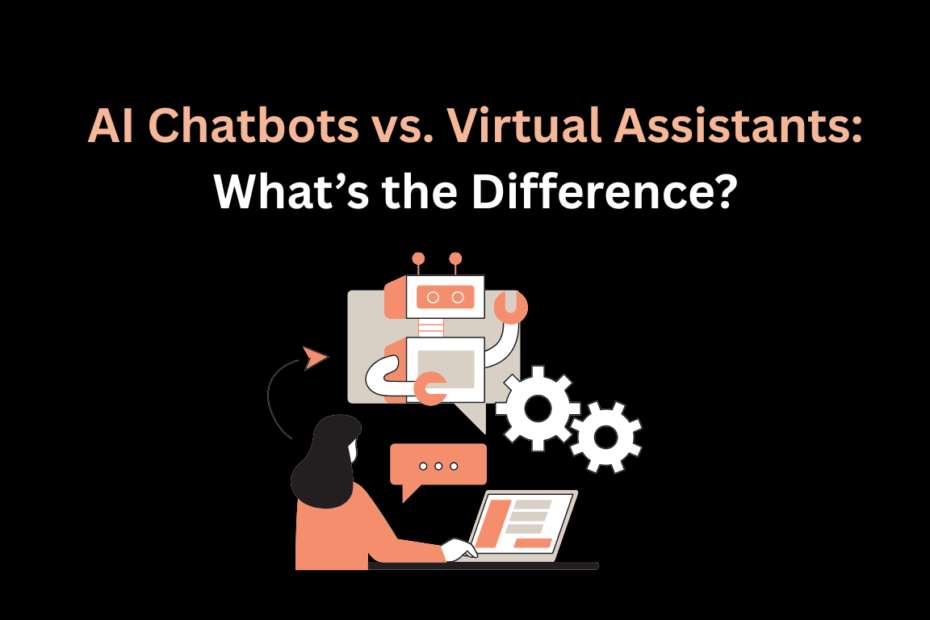As artificial intelligence (AI) continues to evolve, its presence in our daily lives becomes more noticeable—especially through tools like AI chatbots and virtual assistants. While these two terms are often used interchangeably, they serve distinct purposes and are built for different tasks. Understanding the difference between them is crucial for both users and businesses looking to leverage AI solutions effectively.
In this blog, we’ll explore the core differences between AI chatbots and virtual-assistants, examine their use cases, and help you decide which one suits your needs best. Let’s dive into this AI comparison.
What Are AI Chatbots?
AI chatbots are software programs designed to simulate human conversation. They are typically used to handle customer queries, provide information, and perform automated tasks via messaging interfaces. These chatbots are often found on websites, social media platforms, and customer service portals.
Key Features of AI Chatbots:
- Predefined scripts or flows
- Instant response to FAQs
- Integration with CRM or knowledge bases
- Available 24/7
- Task-specific functionality
Most chatbots today use natural language processing (NLP) to interpret user input and respond in a conversational way. Some advanced chatbots, powered by AI models like GPT (Generative Pre-trained Transformer), can engage in more dynamic and human-like conversations.
Common Use Cases for AI Chatbots:
- Answering product or service-related questions
- Booking appointments
- Generating leads
- Handling customer support tickets
- Gathering user feedback
What Are Virtual Assistants?
Virtual-assistants are AI-powered tools designed to assist with more complex, multi-functional tasks. They can interpret voice commands, schedule appointments, manage smart devices, send messages, and much more.
Examples include Apple’s Siri, Amazon Alexa, Google Assistant, and Microsoft’s Cortana. These tools are embedded in smartphones, smart speakers, and other connected devices.
Key Features of Virtual Assistants:
- Voice and text interaction
- Contextual understanding
- Task automation across multiple domains
- Personalized user experience
- Integration with other apps and devices
Unlike chatbots that mostly stay within a specific scope, virtual-assistants aim to be more general-purpose, acting almost like a digital secretary.
Common Use Cases for Virtual Assistants:
- Setting reminders and alarms
- Managing calendars
- Sending emails or messages
- Playing music or podcasts
- Controlling smart home devices
AI Chatbots vs. Virtual Assistants: Key Differences
To make the AI comparison clearer, here’s a breakdown of how AI chatbots and virtual assistants differ across several dimensions:
| Feature | AI Chatbots | Virtual Assistants |
|---|---|---|
| Interface | Mostly text-based | Voice and text |
| Purpose | Task- and goal-specific | General-purpose assistant |
| Complexity | Simple to moderately complex | Advanced AI with contextual memory |
| User Interaction | Based on prompts or keywords | Natural conversation and commands |
| Integration | Specific platforms/websites | Deep integration with devices/apps |
| Learning Capability | Rule-based or AI-driven | Often uses machine learning |
When to Use AI Chatbots
AI chatbots are best suited for businesses and organizations that want to automate repetitive tasks like:
- Responding to common customer service queries
- Collecting contact information
- Directing users to resources
They are cost-effective, scalable, and quick to implement. If you need to handle high volumes of customer interaction without human intervention, chatbots are a smart choice.
When to Use Virtual Assistants
Virtual-assistants are ideal for individuals or teams looking to improve productivity and manage daily tasks. They’re also useful in home automation and hands-free scenarios.
If you want a tool that can help you:
- Manage your schedule
- Interact with smart home devices
- Perform tasks with minimal input
—then a virtual assistant is the better fit.
Can They Work Together?
Absolutely. In fact, many businesses integrate both. For example:
- A virtual assistant might handle a user’s request to “talk to customer support.”
- The request is then routed to an AI chatbot that specializes in customer service.
This hybrid approach ensures seamless communication and enhances the user experience.
The Future of AI Chatbots and Virtual Assistants
As AI advances, the line between chatbots and virtual-assistants is blurring. Future systems may combine the best of both worlds:
- Chatbots with deeper contextual understanding
- Virtual assistants that support business workflows
- Unified AI platforms that evolve with user needs
This convergence will create more intelligent, adaptive, and helpful digital agents that offer both convenience and efficiency.
Conclusion
While both AI chatbots and virtual assistants fall under the umbrella of AI-driven technologies, they serve different purposes. Chatbots are built for structured, goal-oriented conversations—ideal for business interactions. Virtual assistants, on the other hand, offer a more personalized and expansive user experience, making them perfect for productivity and smart living.
By understanding their differences, you can choose the right tool—or combination—for your specific needs. Whether you’re a business owner, developer, or tech enthusiast, knowing how to use these tools effectively can help you harness the full power of AI.
Read More: AI-Powered Tools for Content Creation and Marketing
FAQs
1. What is the main difference between an AI chatbot and a virtual assistant?
AI chatbots handle specific tasks using text, while virtual assistants manage broader functions using voice and text.
2. Are AI chatbots better for businesses?
Yes, they’re ideal for automating customer service and improving response times.
3. Can virtual assistants perform tasks like chatbots?
Yes, but they are generally designed for broader personal or productivity tasks.
4. Do AI chatbots learn over time?
Some do, especially those built with machine learning, but many still follow pre-set rules.
5. Can I use both tools at the same time?
Yes, many systems combine chatbots for specific tasks with virtual assistants for overall interaction.
